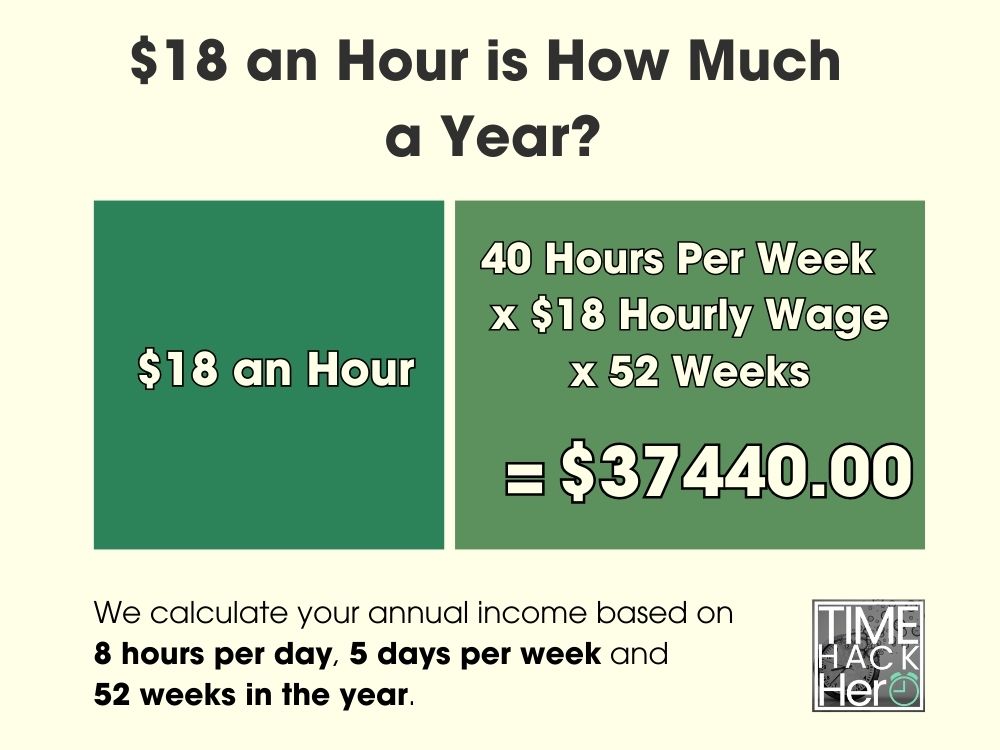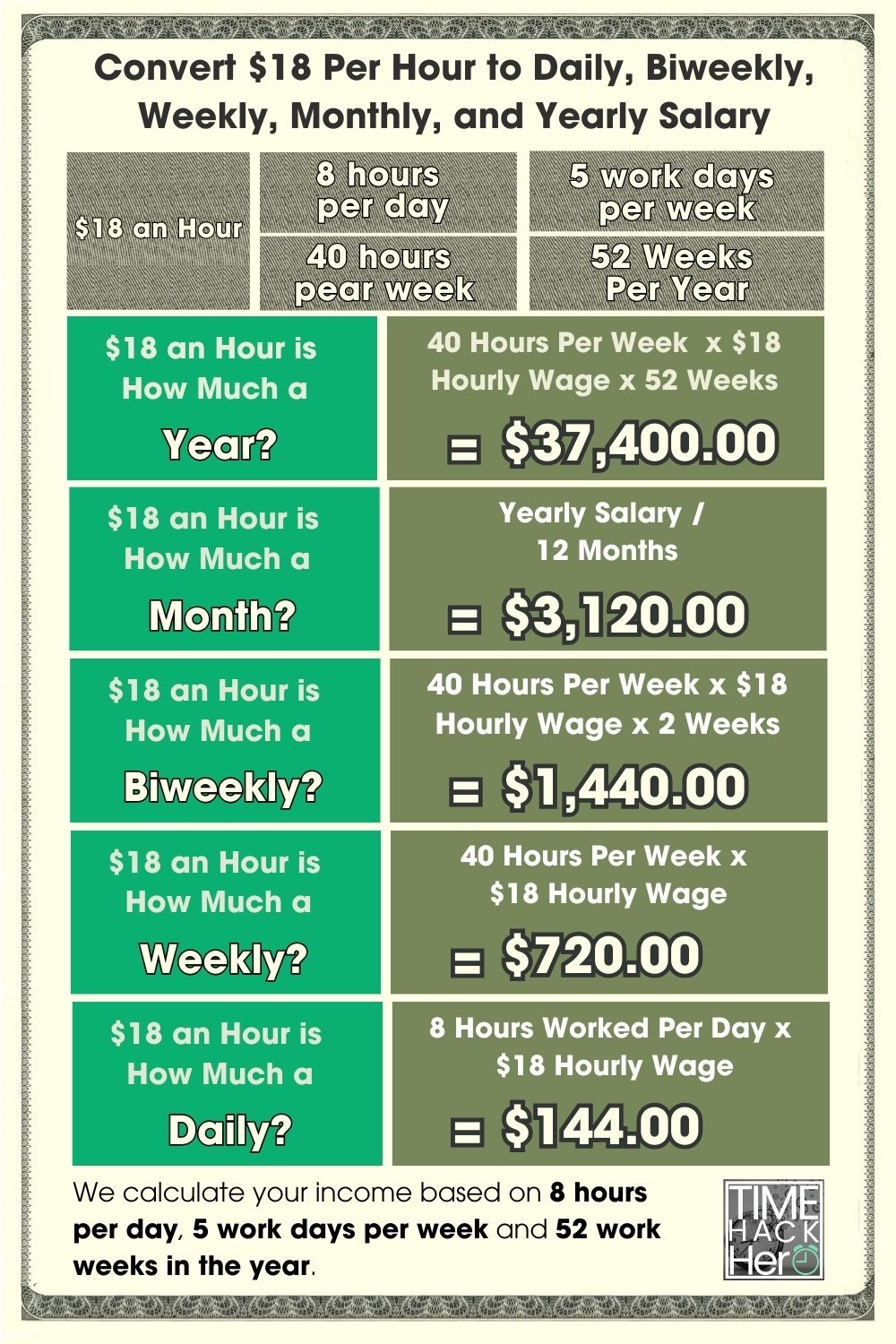Knowing how to convert an hourly wage to annual earnings is important for budgeting and financial planning. In this article, we’ll break down the math for determining a yearly salary from $18 per hour.
We’ll calculate annual pay for both full-time and part-time schedules. We’ll also look at how overtime and unpaid time off impact yearly income at this hourly rate. And because take-home pay is what really matters, we’ll factor in tax withholding to see how it reduces $18/hour to an after-tax salary.
Understanding the annual earnings potential of $18 an hour helps you set savings goals, qualify for major purchases, and assess if it’s a livable wage. While paychecks are issued weekly or biweekly, planning around yearly income allows for bigger picture budgeting. We’ll also look at ways to boost earnings beyond $18/hour through education, skills development, and side gigs.
Let’s explore the critical question: how much per year does $18 an hour equal?
Table of Contents
Convert $18 Per Hour to Weekly, Monthly, and Yearly Salary
Input your wage and hours per week to see how much you’ll make monthly, yearly and more.
$18 an Hour is How Much a Year?
If you make $18 an hour, your yearly salary would be $37,440. We calculate your annual income based on 8 hours per day, 5 days per week and 52 weeks in the year.
Hours worked per week (40) x Hourly wage($18) x Weeks worked per year(52) = $37,440
$18 an Hour is How Much a Month?
If you make $18 an hour, your monthly salary would be $3,120. We calculated this number by dividing your annual income by 12 months.
Hours worked per week (40) x Hourly wage($18) x Weeks worked per year(52) / Months per Year(12) = $3,120
$18 an Hour is How Much a Biweekly?
If you make $18 an hour, your biweekly salary would be $1,440.
Hours worked per week (40) x Hourly wage($18) x 2 = $1,440
$18 an Hour is How Much a Week?
If you make $18 an hour, your weekly salary would be $720. Calculating based on 5 days per week and 8 hours each day.
Hours worked per week (40) x Hourly wage($18) = $720
$18 an Hour is How Much a Day?
If you make $18 an hour, your daily salary would be $144. We calculated your daily income based on 8 hours per day.
Hours worked per day (8) x Hourly wage($18) = $144
$18 an Hour is How Much a Year?
The basic formula to calculate your annual salary from an hourly wage is:
Hourly Rate x Hours Worked per Week x Number of Weeks Worked per Year = Annual Salary
So for a $20 per hour job:
$18 per hour x 40 hours per week x 52 weeks per year = $37,440
However, this simple calculation makes some assumptions:
- You will work 40 hours every week of the year
- You will not get any paid time off
Therefore, it represents your earnings if you worked every week of the year, without any vacation, holidays, or sick days.
Accounting for Paid Time Off
The $37,440 base salary does not yet factor in paid time off (PTO). Let’s assume the job provides:
- 2 weeks (10 days) paid vacation
- 6 paid holidays
- 3 paid sick days
This totals 19 paid days off, or nearly 4 weeks of PTO.
Importantly, this paid time off should not be deducted from the annual salary, since you still get paid for those days.
So with 4 weeks PTO, the annual salary would remain $37,440 .
Part time $18 an hour is How Much a Year?
Your annual income changes significantly if you work part-time and not full-time.
For example, let’s say you work 35 hours per week instead of 40. Here’s how you calculate your new yearly total:
$18 per hour x 35 hours per week x 52 weeks per year = $32,760
By working 5 fewer hours per week (35 instead of 40), your annual earnings at $18 an hour drop from $37,440 to $32,760.
That’s a $4,680 per year difference just by working part-time!
Here’s a table summarizing how your annual earnings change depending on how many hours you work per week at $18 an hour:
| Hours Per Week | Earnings Per Week | Annual Earnings |
|---|---|---|
| 40 | $720 | $37,440 |
| 35 | $630 | $32,760 |
| 30 | $540 | $28,080 |
| 25 | $450 | $23,400 |
| 20 | $360 | $18,720 |
| 15 | $270 | $14,040 |
The more hours per week, the higher your total yearly earnings. But part-time work allows for more life balance if you don’t need the full salary.
$18 an Hour With Overtime is How Much a Year?
Now let’s look at how overtime can increase your annual earnings.
Overtime kicks in once you work more than 40 hours in a week. Typically, you earn 1.5x your regular hourly wage for overtime hours.
So if you make $18 per hour normally, you would make $27 per hour for any hours over 40 in a week.
Here’s an example:
- You work 45 hours in a Week
- 40 regular hours paid at $18 per hour = $720
- 5 overtime hours paid at $27 per hour = $135
- Your total one Week earnings =$720 + $135 = $855
If you worked 45 hours each week for 52 weeks, here’s how your annual earnings increase thanks to overtime pay:
$855 per week x 52 weeks per year = $44,460
That’s $7,020 more than you’d earn working just 40 hours per week at $18 an hour.
Overtime can add up! But also consider taxes and work-life balance when deciding on extra hours.
Here’s a table summarizing how your annual earnings change depending on how many hours you work per week at $18 an hour:
| Overtime hours per work day | Hours Per Week | Earnings Per Week | Annual Earnings |
| 0 | 40 | $720 | $37,440 |
| 1 | 45 | $855 | $44,460 |
| 2 | 50 | $990 | $51,480 |
| 3 | 55 | $1,125 | $58,500 |
| 4 | 60 | $1,260 | $65,520 |
| 5 | 65 | $1,395 | $72,540 |
| 6 | 70 | $1,530 | $79,560 |
| 7 | 75 | $1,665 | $86,580 |
How Unpaid Time Off Impacts $18/Hour Yearly Earnings
So far we’ve assumed you work 52 paid weeks per year. Any unpaid time off will reduce your total income.
For example, let’s say you take 2 weeks of unpaid leave. That brings your paid weeks down to 50:
Hours worked per week (40) x Hourly wage($18) x Weeks worked per year(50) = $36,000 annual salary
With 2 weeks unpaid time off, your annual earnings at $18/hour would drop by $1,440.
The table below summarizes how your annual income changes depending on the number of weeks of unpaid leave.
| Weeks of unpaid leave | Paid weeks per year | Earnings Per Week | Annual Earnings |
| 0 | 52 | $720 | $37,440 |
| 1 | 51 | $720 | $36,720 |
| 2 | 50 | $720 | $36,000 |
| 3 | 49 | $720 | $35,280 |
| 4 | 48 | $720 | $34,560 |
| 5 | 47 | $720 | $33,840 |
| 6 | 46 | $720 | $33,120 |
| 7 | 45 | $720 | $32,400 |
Key Takeaways for $18 Hourly Wage
In summary, here are some key points on annual earnings when making $18 per hour:
- At 40 hours per week, you’ll earn $37,440 per year.
- Part-time of 30 hours/week results in $28,080 annual salary.
- Overtime pay can boost yearly earnings, e.g. $7,020 extra at 45 hours/week.
- Unpaid time off reduces your total income, around $1,440 less per 2 weeks off.
- Your specific situation and location impacts taxes and PTO.
Knowing your approximate annual salary and factors impacting it makes it easier to budget and plan your finances. The next step is calculating take-home pay after deductions like taxes.
$18 An Hour Is How Much A Year After Taxes
Figuring out your actual annual earnings based on an hourly wage can be complicated once taxes are taken into account. In addition to federal, state, and local income taxes, 7.65% of your gross pay also goes to Social Security and Medicare through FICA payroll taxes. So how much does $18 an hour equal per year after FICA and income taxes are deducted from your gross pay?
Below we’ll walk through the steps to calculate your annual net take home pay if you make $18 per hour. This will factor in estimated federal, FICA, state, and local taxes so you know exactly what to expect.
Factoring in Federal Income Tax
Your federal income tax will be a big chunk out of your gross pay. Federal tax rates range from 10% to 37%, depending on your tax bracket.
To estimate your federal income tax rate and liability:
Look up your federal income tax bracket based on your gross pay.
2023 tax brackets: single filers
| Tax rate | Taxable income bracket | Tax owed |
|---|---|---|
| 10% | $0 to $11,000. | 10% of taxable income. |
| 12% | $11,001 to $44,725. | $1,100 plus 12% of the amount over $11,000. |
| 22% | $44,726 to $95,375. | $5,147 plus 22% of the amount over $44,725. |
| 24% | $95,376 to $182,100. | $16,290 plus 24% of the amount over $95,375. |
| 32% | $182,101 to $231,250. | $37,104 plus 32% of the amount over $182,100. |
| 35% | $231,251 to $578,125. | $52,832 plus 35% of the amount over $231,250. |
| 37% | $578,126 or more. | $174,238.25 plus 37% of the amount over $578,125. |
For example, if you are single with $37,440 gross annual pay, your federal tax bracket is 12%.
Your estimated federal tax would be:
$1,100 + ($37,440 – $11,000) x 12% = $4,272.80
So at $18/hour with $37,440 gross pay, you would owe about $4,272.80 in federal income taxes.
Considering State Income Tax
In addition to federal tax, most states also charge a state income tax. State income tax rates range from about 1% to 13%, with most falling between 4% and 6%.
Key Takeaways
-
- California, Hawaii, New York, New Jersey, and Oregon have some of the highest state income tax rates.
- Alaska, Florida, Nevada, South Dakota, Tennessee, Texas, Washington, and Wyoming don’t impose an income tax at all.
- Another 10 U.S states have a flat tax rate—everyone pays the same percentage regardless of how much they earn.
A State-by-State Comparison of Income Tax Rates
| STATE | TAX RATES | LOWEST AND HIGHEST INCOME BRACKETS |
|---|---|---|
| Alaska | 0% | None |
| Florida | 0% | None |
| Nevada | 0% | None |
| South Dakota | 0% | None |
| Tennessee | 0% | None |
| Texas | 0% | None |
| Washington | 0% | None |
| Wyoming | 0% | None |
| Colorado | 4.55% | Flat rate applies to all incomes |
| Illinois | 4.95% | Flat rate applies to all incomes |
| Indiana | 3.23% | Flat rate applies to all incomes |
| Kentucky | 5% | Flat rate applies to all incomes |
| Massachusetts | 5% | Flat rate applies to all incomes |
| New Hampshire | 5% | Flat rate on interest and dividend income only |
| North Carolina | 4.99% | Flat rate applies to all incomes |
| Pennsylvania | 3.07% | Flat rate applies to all incomes |
| Utah | 4.95% | Flat rate applies to all incomes |
| Michigan | 4.25% | Flat rate applies to all incomes |
| Arizona | 2.59% to 4.5% | $27,806 and $166,843 |
| Arkansas | 2% to 5.5% | $4,300 and $8,501 |
| California | 1% to 13.3% | $9,325 and $1 million |
| Connecticut | 3% to 6.99% | $10,000 and $500,000 |
| Delaware | 0% to 6.6% | $2,000 and $60,001 |
| Alabama | 2% to 5% | $500 and $3,001 |
| Georgia | 1% to 5.75% | $750 and $7,001 |
| Hawaii | 1.4% to 11% | $2,400 and $200,000 |
| Idaho | 1.125% to 6.5% | $1,568 and $7,939 |
| Iowa | 0.33% to 8.53% | $1,743 and $78,435 |
| Kansas | 3.1% to 5.7% | $15,000 and $30,000 |
| Louisiana | 1.85% to 4.25% | $12,500 and $50,001 |
| Maine | 5.8% to 7.15% | $23,000 and $54,450 |
| Maryland | 2% to 5.75% | $1,000 and $250,000 |
| Minnesota | 5.35% to 9.85% | $28,080 and $171,221 |
| Mississippi | 0% to 5% | $5,000 and $10,001 |
| Missouri | 1.5% to 5.3% | $1,121 and $8,968 |
| Montana | 1% to 6.75% | $2,900and $17,400 |
| Nebraska | 2.46% to 6.84% | $3,340 and $32,210 |
| New Jersey | 1.4% to 10.75% | $20,000 and $1 million |
| New Mexico | 1.7% to 5.9% | $5,500 and $210,000 |
| New York | 4% to 10.9% | $8,500 and $25 million |
| North Dakota | 1.1% to 2.9% | $41,775 and $458,350 |
| Ohio | 0% to 3.99% | $25,000 and $110,650 |
| Oklahoma | 0.25% to 4.75% | $1,000 and $7,200 |
| Oregon | 4.75% to 9.9% | $3,750 and $125,000 |
| Rhode Island | 3.75% to 5.99% | $68,200 and $155,050 |
| South Carolina | 0% to 7% | $3,110 and $15,560 |
| Vermont | 3.35% to 8.75% | $42,150 and $213,150 |
| Virginia | 2% to 5.75% | $3,000 and $17,001 |
| Washington, D.C. | 4% to 9.75% | $10,000 and $1 million |
| West Virginia | 3% to 6.5% | $10,000 and $60,000 |
| Wisconsin | 3.54% to 7.65% | $12,760 and $280,950 |
To estimate your state income tax:
Look up your state income tax rate based on your gross pay and filing status.
Multiply your gross annual pay by the state tax rate.
For example, if you live in Pennsylvania which has a flat 3.07% tax rate, your estimated state tax would be:
$37,440 gross pay x 3.07% PA tax rate = $1,149.41 estimated state income tax
So with $37,440 gross annual income, you would owe around in $1,149.41 Pennsylvania state income tax. Verify your specific state’s income tax rates.
Factoring in Local Taxes
Some cities and counties levy local income taxes ranging from 1-3% of taxable income.
To estimate potential local taxes you may owe:
- Check if your city or county charges a local income tax.
- If yes, look up the local income tax rate.
- Multiply your gross annual pay by the local tax rate.
For example, say you live in Columbus, OH which has a 2.5% local income tax. Your estimated local tax would be:
$37,440 gross pay x 2.5% local tax rate = $936 estimated local tax
So with $37,440 in gross earnings, you may owe around $936 in Columbus local income taxes. Verify rates for your own city/county.
Accounting for FICA Taxes (Social Security & Medicare)
FICA taxes are a combination of Social Security and Medicare taxes that equal 15.3% of your earnings. You are responsible for half of the total bill (7.65%), which includes a 6.2% Social Security tax and 1.45% Medicare tax on your earnings.
In 2023, only the first $160,200 of your earnings are subject to the Social Security tax
There is an additional 0.9% surtax on top of the standard 1.45% Medicare tax for those who earn over $200,000 (single filers) or $250,000 (joint filers).
To estimate your FICA tax payment:
$37,440 x 6.2% + $37,440 x 1.45% = $2,864.16
So you can expect to pay about $2,864.16 in Social Security and Medicare taxes out of your gross $37,440 in earnings.
Total Estimated Tax Payments
Based on the examples above, your total estimated tax payments would be:
Federal tax: $4,272.80
State tax: $1,149.41
Local tax: $936
FICA tax: $2,864.16
Total Estimated Tax: $9,222.37
Calculating Your Take Home Pay
To calculate your annual take home pay at $18 /hour:
1. Take your gross pay
2. Subtract your estimated total tax payments
$37,440 gross pay – $9,222.37 Total Estimated Tax = $28,217.63 Your Take Home Pay
n summary, if you make $18 per hour and work full-time, you would take home around $28,217.63 per year after federal, state, local , FICA taxes.
Your actual net income may vary depending on your specific tax situation. But this gives you a general idea of what to expect.
Convert $18 Per Hour to Yearly, Monthly, Biweekly, and Weekly Salary After Taxes
If you make $18 an hour and work full-time (40 hours per week), your estimated yearly salary would be $37,440 .
The $37,440 per year salary does not account for taxes. Federal, state, and local taxes will reduce your take-home pay. The amount withheld depends on your location, filing status, dependents, and other factors.
Just now during our calculation of $18 An Hour Is How Much A Year After Taxes, we assumed the following conditions:
- You are single with $37,440 gross annual pay, your federal tax bracket is 12 %.
- You live in Pennsylvania which has a flat 3.07% tax rate
- You live in Columbus, OH which has a 2.5% local income tax.
In the end, we calculated your Total Estimated Tax is $9,222.37 , Your Take Home Pay is $28,217.63 , Total tax rate is 24.63%.
So next we’ll use 24.63% as the estimated tax rate to calculate your weekly, biweekly, and monthly after-tax income.
$18 Per Hour to Yearly, Monthly, Biweekly, Weekly,and Week Salary After Taxes Table
| Income before taxes | Estimated Tax Rate | Income Taxes | After Tax Income | |
| Yearly Salary | $37,440 | 24.63% | $9,222.37 | $28,217.63 |
| Monthly Salary | $3,120 | 24.63% | $768.53 | $2,351.47 |
| BiWeekly Salary | $1,440 | 24.63% | $354.71 | $1,085.29 |
| Weekly Salary | $720 | 24.63% | $177.35 | $542.65 |
$18 an hour is how much a year after taxes
Here is the adjusted yearly salary after a 24.63% tax reduction:
-
- Yearly salary before taxes: $37,440
- Estimated tax rate: 24.63%
- Taxes owed (24.63% * $37,440 )= $9,222.37
- Yearly salary after taxes: $28,217.63
| Hourly Wage | Hours Worked Per Week | Weeks Worked Per Year | Total Yearly Salary | Estimated Tax Rate | Taxes Owed | After-Tax Yearly Salary |
|---|---|---|---|---|---|---|
| $18 | 40 | 52 | $37,440 | 24.63% | $9,222.37 | $28,217.63 |
$18 an hour is how much a month after taxes
To calculate the monthly salary based on an hourly wage, you first need the yearly salary amount. Then divide by 12 months.
-
-
- Yearly salary before taxes at $18 per hour: $37,440
- Divided by 12 months per year: $37,440 / 12 = $3,120 per month
-
The monthly salary based on a 40 hour work week at $18 per hour is $3,120 before taxes.
After applying the estimated 24.63% tax rate, the monthly after-tax salary would be:
-
- Monthly before-tax salary: $3,120
- Estimated tax rate: 24.63%
- Taxes owed (24.63% * $3,120 )= $768.53
- Monthly after-tax salary: $2,351.47
Monthly Salary Based on $18 Per Hour
| Hourly Wage | Yearly Salary | Months Per Year | Before-Tax Monthly Salary | Estimated Tax Rate | Taxes Owed | After-Tax Monthly Salary |
|---|---|---|---|---|---|---|
| $18 | $37,440 | 12 | $3,120 | 24.63% | $768.53 | $2,351.47 |
$18 an hour is how much biweekly after taxes
Many people are paid biweekly, meaning every other week. To calculate the biweekly pay at $18 per hour:
- Hourly wage: $18
- Hours worked per week: 40
- Weeks per biweekly pay period: 2
- $18 * 40 hours * 2 weeks = $1,440 biweekly
Applying the 24.63%estimated tax rate:
- Biweekly before-tax salary: $1,440
- Estimated tax rate: 24.63%
- Taxes owed (24.63% * $1,440 )= $354.71
- Biweekly after-tax salary: $1,085.29
Biweekly Salary at $18 Per Hour
| Hourly Wage | Hours Worked Per Week | Weeks Per Pay Period | Before-Tax Biweekly Salary | Estimated Tax Rate | Taxes Owed | After-Tax Biweekly Salary |
|---|---|---|---|---|---|---|
| $18 | 40 | 2 | $1,440 | 24.63% | $354.71 | $1,085.29 |
$18 an hour is how much weekly after taxes
To find the weekly salary based on an hourly wage, you need to know the number of hours worked per week. At 40 hours per week, the calculation is:
- Hourly wage: $18
- Hours worked per week: 40
- $18 * 40 hours = $720 per week
Accounting for the estimated 24.63% tax rate:
- Weekly before-tax salary: $720
- Estimated tax rate: 24.63%
- Taxes owed (24.63% * $720 )= $177.35
- Weekly after-tax salary: $542.65
Weekly Salary at $18 Per Hour
| Hourly Wage | Hours Worked Per Week | Before-Tax Weekly Salary | Estimated Tax Rate | Taxes Owed | After-Tax Weekly Salary |
|---|---|---|---|---|---|
| $18 | 40 | $720 | 24.63% | $177.35 | $542.65 |
Key Takeaways
- An hourly wage of $18 per hour equals a yearly salary of $37,440 before taxes, assuming a 40 hour work week.
- After accounting for an estimated 24.63% tax rate, the yearly after-tax salary is approximately $28,217.63 .
- On a monthly basis before taxes, $18 per hour equals $3,120 per month. After estimated taxes, the monthly take-home pay is about $2,351.47 .
- The before-tax weekly salary at $18 per hour is $720 . After taxes, the weekly take-home pay is approximately $542.65 .
- For biweekly pay, the pre-tax salary at $18 per hour is $1,440 . After estimated taxes, the biweekly take-home pay is around $1,085.29 .
Understanding annual, monthly, weekly, and biweekly salary equivalents based on an hourly wage is useful when budgeting and financial planning. Taxes make a significant difference in take-home pay, so be sure to account for them when making income conversions. Use this guide as a reference when making salary calculations.
What Is the Average Hourly Wage in the US?
Last Updated: Sep 1 2023
US Average Hourly Earnings is at a current level of $33.82, up from 33.74 last month and up from 32.43 one year ago. This is a change of 0.24% from last month and 4.29% from one year ago.
Average Hourly Earnings is the average dollars that a private employee makes per hour in the US. This metric is a part of one of the most important releases every month which includes unemployment numbers as well. This is normally released on the first Friday of every month. This metric is released by the Bureau of Labor Statistics (BLS).
What is the average salary in the U.S.?
Last Updated: July 18, 2023
The U.S. Bureau of Labor Statistics uses median salary data rather than averages to avoid skewed numbers from outlying high and low numbers. Median weekly earnings of the nation's 121.5 million full-time wage and salary workers were $1,100 in the second quarter of 2023, the U.S.
If a person works 52 weeks in the year, then this represents a national annual salary of $57,200.
Is $18 an Hour a Good Salary?
Whether $18 an hour is a good wage largely depends on where you live, your lifestyle, and the size of your household.
For a single individual living in a smaller town in the Midwest or South, $18 an hour can provide a decent quality of life. However, for larger cities with a higher cost of living like New York City or San Francisco, this hourly wage would make it much harder to get by.
According to the MIT Living Wage Calculator, here are some examples of the required living wage for a single adult in different parts of the country:
- New York City: $20.19 per hour
- Chicago: $15.24 per hour
- Houston: $15.35 per hour
- Charlotte: $13.92 per hour
So in lower cost areas, $18 an hour meets or exceeds the typical living wage. But in pricier cities, it falls short.
The situation becomes even tougher when supporting a family on $18 an hour. As household size grows, so do expenses. While a single person may get by on this wage, it would be challenging for a family with 2-3 children without relying heavily on government assistance programs.
Jobs that pay $18 an hour
There are a variety of jobs that typically pay around $18 per hour:
- Administrative assistants – Perform clerical duties in an office such as answering phones, data entry, preparing reports, scheduling appointments, etc. Often require some college coursework.
- Phlebotomists – Draw blood from patients and donors. Usually requires completion of a phlebotomy training program.
- Food service managers – Oversee daily operations of restaurants and dining establishments. Generally need 1-3 years of experience in the food industry.
- Sales representatives – Sell products and services to businesses or consumers via phone, email, in-person sales calls, presentations, etc. May require a high school diploma or bachelor’s degree depending on the industry and products sold.
- Bookkeepers – Record financial transactions for companies and organizations. Typically need some college coursework in accounting or bookkeeping.
- Preschool teachers – Instruct children below kindergarten age at daycares, preschools, and pre-K programs. Requirement is often an associate’s degree.
- Fitness trainers – Provide exercise instruction and wellness advice to clients at gyms or private studios. Usually need a high school diploma or associate’s degree.
- Paralegals – Assist lawyers by conducting legal research, preparing documents, communicating with clients. Most positions require an associate’s degree in paralegal studies.
These are just some examples of jobs in the $15 to $20 per hour range. The education and experience required will vary.
Can You Live Off $18 An Hour?
Whether or not it’s possible to live comfortably on $18 an hour depends largely on where you live and your overall budget. For single adults and dual-income households without children in lower cost-of-living areas, it is certainly doable to live off this wage. However, for expensive cities and for those supporting families, it would be challenging without relying on government assistance, cutting back spending, or working more than 40 hours per week.
To determine if you can live on $18 an hour, start by breaking down your monthly expenses:
- Housing
- Food
- Transportation
- Healthcare
- Utilities
- Debt payments
- Entertainment/leisure
- Miscellaneous expenses
As a general rule, your housing costs (including rent/mortgage, utilities, insurance, etc.) should not exceed 30% of your pre-tax income. For someone making $18 an hour or ~$2,933 per month pre-tax, that means housing costs ideally should stay under $880.
In many parts of the country, it’s possible to find an apartment or room rental within that budget. However, in high-cost metro areas like Los Angeles, New York, San Francisco and Boston, paying less than 30% of your income on rent would be very difficult at this wage.
Overall, maintaining a detailed budget and minimizing any unnecessary expenses is key to living on $18 per hour. Avoiding costly housing situations and limiting debt can help significantly.
The impact of inflation on the value of $18 an hour
With inflation recently reaching its highest level in 40 years, the real value of $18 an hour has decreased significantly. While nominal wage growth has kept pace over the past couple years, when accounting for inflation most workers have experienced a decline in real wages.
In 2021, $18 an hour equated to about $37,440 per year. But with inflation around 8% annually, real wages have dropped by several percentage points.
This means that even though $18 an hour results in the same gross pay as last year, workers are able to purchase less with their earnings due to rising prices. From housing and food costs to transportation and healthcare, most major expenses have become more expensive.
Unless wages begin increasing faster than inflation (for example, getting a 10% raise when inflation is 8%), real purchasing power will continue to decline. So in terms of real value, $18 today buys less than it did just a couple years ago.
This squeeze on wages from inflation makes it even harder for lower and middle income workers to maintain their standard of living. Those earning around $18 an hour feel these impacts the most.
5 Ways To Increase Your Hourly Wage
If you’re currently earning around $18 per hour but struggling to make ends meet, here are some options to increase your earnings:
- Ask for a raise – If you’ve been at your company for a while and have a good performance record, request a wage increase to keep pace with the cost of living. Prepare a case with market salary data.
- Find a higher paying job – Browse job ads and sites like Glassdoor to find openings with better pay. Update your resume and LinkedIn profile.
- Pick up side work – Take on part-time gigs like rideshare driving, tutoring, freelance writing etc. to supplement your primary income.
- Develop new skills – Take online courses or classes to gain skills that qualify you for higher-paying roles.
- Start a side business – Launch a small business like selling products online, consulting, bookkeeping services to earn extra income.
- Negotiate benefits – If your employer won’t raise wages, see if they can improve benefits like more paid vacation days.
- Move to a lower cost area – Research cities or towns with a lower cost of living where your earnings will stretch further.
Combining multiple strategies can help provide the income boost you need to thrive on $18 an hour.
Buying a car on $18 an hour
For most people, a car is necessary to get to work and complete day-to-day errands. But cars also represent a major expense. Is it possible to afford a car if you make $18 an hour?
The short answer – yes, but choose carefully. The average monthly car payment in the U.S. is around $550. But for someone taking home $2,933 per month before taxes on $18 an hour, a payment that high would account for nearly 19% of pre-tax income – above the recommended 15% maximum.
Here are some tips for buying a car on an $18 per hour salary:
- Shop used – Opt for a used vehicle instead of new – used cars are 40-60% cheaper than new models. Find well-maintained used options with lower miles.
- Get pre-approved – Talk to your bank, credit union or lender before shopping to secure an auto loan. This allows you to know your budget.
- Prioritize reliability – Look for durable, reliable models with a strong reputation. Avoid vehicles prone to repairs and maintenance issues.
- Consider a longer loan term – Extending your repayment term to 60 or 72 months instead of 48 can dramatically lower monthly payments. Just avoid extending too long.
- Buy below your budget – Get a car significantly below the maximum payment you’re approved for. This leaves budget room for insurance, gas and repairs.
- Save up a down payment – Putting 10-20% down reduces the amount you have to finance. Even better, pay with cash if possible.
As long as you’re strategic – getting pre-approved, buying used, and choosing an affordable payment – purchasing a car on an $18 per hour income is feasible. Just be sure to budget properly for the added expenses that come with car ownership.
Can You Buy a House on $18 An Hour?
For many Americans, owning a home remains an important financial milestone and a key means of building long-term wealth. But is buying a house achievable if you earn around $18 per hour?
In most markets, it would be extremely challenging to purchase a home on this salary alone. However, it may be possible with the following strategies and caveats:
- Save a substantial down payment – Putting 10-20% down helps keep monthly mortgage costs manageable. With disciplined saving over several years, this is doable on $18/hour.
- Find down payment assistance programs – First-time homebuyer programs offer grants or loans to cover some or all of a down payment to those who qualify by income.
- Consider USDA, VA loans – These specialized mortgages require little or no down payment, have flexible credit requirements, and lower interest rates. Eligibility is based on location and service.
- Shop lower cost markets – You’ll have far more buying power in cities with lower home prices and property taxes. Avoid high-cost urban areas.
- Purchase a modest home – Opt for a small, simple starter home with fewer amenities and maintenance costs.
- Get a co-signer – Having a co-signer with good credit helps you qualify and get better loan terms.
- Consider a part-time job – Additional income from a side gig can help you afford a mortgage payment.
Owning on $18 per hour requires discipline and sacrifice, but it is possible in the right market with the right preparation. Just be realistic about how much house you can safely afford.
Example Budget For $18 Per Hour
To determine if living on $18 an hour is feasible for you, it helps to map out an example monthly budget:
Income
- Monthly Take-Home Pay (after taxes): $2,933
- Side Income: $500
- Total: $3,433
Expenses
- Rent: $800 (with roommates or in low cost area)
- Car Payment: $200 (used car)
- Car Insurance: $100
- Gas: $80
- Groceries: $250
- Dining Out: $200
- Entertainment: $100
- Utilities: $150
- Phone: $80
- Internet: $50
- Medical: $75 (with employer insurance)
- Miscellaneous: $150
- Total: $2,235
Remaining:
- $1,198 left per month
This allows you to cover all typical living expenses, make contributions to savings, and still have extra money left over each month. An $18 per hour income can certainly support a decent lifestyle in many areas with careful budgeting.
However, the feasibility varies drastically depending on specific circumstances:
- Housing costs and availability
- Family size and expenses
- Debt payments
- Health considerations
Single individuals and dual-income couples stand the best chance of thriving on this salary. But for single parents or families with multiple children, it would require major cutbacks and assistance.
In Summary
For single adults and working couples without children, $18 an hour provides a living wage in many parts of the country. However, it also requires carefully budgeting and finding ways to maximize that income through side work, benefits, expense minimization, and smart financial choices. For those supporting families or living in high-cost areas, an $18 per hour salary presents a much tougher scenario without sufficient government assistance.
The value of $18 an hour has also declined notably over the past couple years due to rampant inflation. So earning the same nominal wage as before the pandemic provides less real purchasing power. This squeeze of inflation on fixed income households makes thriving on $18 per hour much more difficult.
Overall, it’s certainly possible to live on $18 an hour depending on your individual circumstances. But challenges remain, and this salary provides little room for financial surprises or emergencies. For many, living comfortably on this wage requires supplemental income sources and very careful money management.










